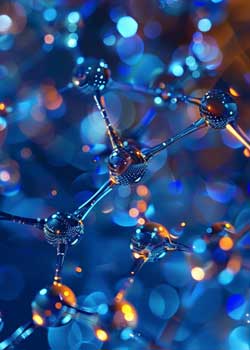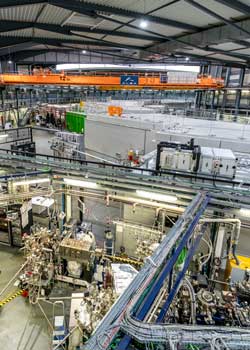Jordi Arbiol (ICREA & Catalan Institute of Nanoscience and Nanotechnology (ICN2), CSIC & BIST)
Carmen Ocal (Institute of Materials Sciences of Barcelona, ICMAB-CSIC)
Aitor Mugarza (ICREA & Catalan Institute of Nanoscience and Nanotechnology (ICN2), CSIC & BIST)
Lucía Aballe (ALBA Synchrotron)

The In-situ Correlative Facility for Advanced Energy Materials (InCAEM), directly linked to the ALBA Synchrotron, is in full development to enable correlative in-situ (Scanning) Transmission Electron Microscopy ((S)TEM), Scanning Probe Microscopies (SPM) and synchrotron radiation experiments for addressing some of the scientific challenges of the European Green Deal plan, to promote a more sustainable EU economy. It is part of the Planes Complementarios program, within the Advanced Materials project, launched and cofunded by the Ministry of Science and Innovation together with the Generalitat de Catalunya, with the support of NextGeneration EU funds.
The joint collaboration team from the ICN2, ICMAB-CSIC, IFAE-PIC and ALBA Synchrotron is working to install and commission a unique infrastructure that will enable the scientific community and industrial users to perform correlative in-situ experiments, combining (S)TEM and SPM (AFM/STM) instrumentation with synchrotron radiation techniques at different beamlines of the ALBA Synchrotron.
InCAEM is envisioned as a key tool for the whole community to tackle advanced characterization challenges, down to the atomic scale, of advanced materials analyzed under working conditions, subject to different environments (gas, liquid, biasing, temperature). For example, in advanced catalyst materials for energy and environmental applications, which are mainly based on oxides and metal-based nanostructures. In this type of nanostructures, small changes on the surface at the atomic level, such as presence of dopants, vacancies, voids, or slight differences in the atomic structure can strongly influence their final behavior. Present state-of-the-art characterization methods are insufficient for the simultaneous observation of atomic structure and measurement of local physical/chemical properties. The combination of atomic-scale structural and chemical characterization with in-situ measurements based on a powerful combination of electron microscopy and synchrotron techniques on the very same sample will yield a much better understanding of these chemical reactions.
Beyond the different instruments to be installed and/or adapted, InCAEM also includes the development of a robust computing infrastructure and methods for automated data analysis, particularly for in-situ experiments. This approach is necessary in view of the enormous amount of data expected in order to streamline the experimental workflow, enhance data interpretation, and accelerate scientific discovery, ultimately advancing our understanding of materials for energy and environmental applications.
Below, we summarize the main characteristics of the different instruments included in the facility as well as their scientific potential.
Advanced state-of-the-art monochromated and double aberration corrected (S)TEM |
|
 |
During the first quarter of 2025, an advanced state-of-the-art monochromated and double aberration corrected (S)TEM will be installed at the Joint Electron Microscopy Center at ALBA (JEMCA), representing a significant leap forward in materials analysis, particularly for applications in energy and environmental research. This cutting-edge STEM system, with operational voltages ranging from 30 to 300 keV, promises unparalleled capabilities for in-situ analyses, crucial for understanding dynamic processes in materials under realistic conditions. With a spatial resolution of 39 pm at 300 keV and sub-angstrom resolution above 60 keV, this STEM system will offer the ability to visualize atomic-scale structures and dynamics with unprecedented clarity. Such high-resolution imaging is essential for studying the intricate architectures of materials used in energy storage, catalysis, and environmental remediation. Furthermore, the exceptional energy resolution, expected to be below 25 meV, facilitates precise characterization of electronic properties and chemical bonding within materials. This capability will be invaluable for elucidating the mechanisms underlying energy conversion processes and catalytic reactions. The incorporation of 4D STEM capabilities through the CMOS camera and pixelated direct electron detector enables comprehensive spatiotemporal analysis, allowing researchers to track dynamic changes in materials with exceptional detail and accuracy. This feature will be particularly advantageous for studying transient phenomena and reaction kinetics in real time. Additionally, the inclusion of a high-collection-angle Energy Dispersive X-ray Spectroscopy (EDX) system will enable rapid and accurate composition mapping down to atomic resolution. This capability is indispensable for characterizing the elemental distribution and chemical heterogeneity within complex materials systems even under in-situ conditions, where a fast compositional mapping is required. Moreover, the integration of an unprecedented Electron Energy Loss Spectroscopy (EELS) system with enhanced capabilities will ensure fast acquisition of high-energy resolution spectra, enabling detailed analysis of electronic structure and bonding configurations in materials. The provision of sample holder systems for catalysis, electrochemistry, and temperature-dependent in-situ experiments will enable controlled environments such as gas mixing and flow, liquid flow with biasing on electrodes, and precise temperature control ranging from -160 to 800 ºC. Such capabilities are essential for studying materials under realistic operating conditions, mimicking those encountered in energy conversion devices and environmental applications. |
A new SPM Platform |
|
 |
Within the project a new SPM Platform will be setup in the ALBA premises. It will host five different instruments, each one with specific, complementary capabilities. Two microscopes will provide state-of-art multi-technique AFM (KPFM, MFM, EFM, LFM, PFM, SCM, Phase contrast, C-AFM, ECM) capability, whereas other two will add optical nanospectroscopies such as tip-enhanced electro and photo luminescence (STML/TEPL) or Raman (TERS) to the toolkit. The fifth equipment is a commercial STM/nc-AFM(UHV)@RT from SPECS using a Nanonis electronics that is working since 2011 at the ALBA installations. This instrument has a load-lock for fast samples entry and is compatible with ALBA suitcases for transfer of samples under UHV. In April 2024, the two new multi-technique AFMs have been delivered. Since the new laboratory at ALBA, designed to host the whole SPM platform, these systems are temporarily installed at the ICMAB-CSIC. The ICMAB team, that includes personnel enrolled within InCAEM, has been in charge of the acquisition and coordinates the installation and commissioning of these equipment. In particular, these multipurpose SPMs are two state-of-the-art FX40 Atomic Force Microscopes from Park Systems. The FX40 AFMs are quite new in the market, with the latest advances in optimization for automatic sensor change and laser alignment. They will permit measuring very diverse samples and materials for applications in fields as varied as biomedicine, energy, electronics, etc. Both AFMs have the same basic layout and are equipped with a series of interchangeable accessories. However, in order to cover a wider range of applications and provide a higher output, each instrument will be initially designed for a different set of measuring modes and environments. While one will operate mainly in ambient conditions, the other one will operate inside a glovebox. This last requirement is quite unique worldwide and, allowing high control of environment and humidity, opens new and challenging opportunities in the study of sensitive and unstable material. It will be thus possible to characterize not only the morphology and mechanical, electrical and magnetic properties on the surface at the nanoscale in diverse ambiances but also to follow, for example, in-situ dynamics or chemical reactions using electrochemical cells. The other two instruments, managed by ICN2, will have the singularity of combining SPM and optical spectroscopies, enabling the correlation of optical, electronic, magnetic, thermal, chemical, and structural information down to the sub-nm scale. One equipment will be operated in controlled gas and liquid environments, enabling operando measurements under different environments, or in electrochemical cells. All common AFM/STM modes will be accessible (STM, KPFM, MFM, EFM, LFM, PFM, SCM, Phase contrast, C-AFM). Optical spectroscopies will be dedicated to the VIS regime, aiming at extending to the NIR in the near future. Polarization dependent measurements will also be accessible. Singular features of the equipment will be the capability to study very low energy Raman modes (<10 cm-1), which enables the study of acoustic phonon modes and other low energy excitations, and the exceptionally high wavelength resolution (<0.2 cm-1), which enables the use of Raman spectroscopy for accurate thermal mapping, measurement of elastic constant of 2D materials, or for tracking small perturbations related to chemical interactions, doping, strain, etc. Multiscale studies will be conducted by combining the 10 nm resolution of tip-enhanced spectroscopies with the 500 nm resolution of a confocal microscope that is integrated in the equipment. The second instrument will be operated in ultra-high vacuum (UHV) and cryogenic (5 K) conditions. The microscope chamber will be coupled to a materials growth chamber equipped for the growth of organic and inorganic films and nanostructures. The STM/nc-AFM head will have vertical and lateral spatial resolution of 1 pm and 100 pm respectively, which enables to bring structural and spectroscopic studies down to the single atom level. It will also have the capability to carry out elastic and inelastic spectroscopy in the presence of a magnetic field (1 T perpendicular to sample) with sub-meV resolution, giving access to the study of ground state electronic states, but also to low energy excitations such as vibrational, spin, Cooper pairs, Shiba states, etc. The optical spectroscopy set-up will have excitation sources in the VIS regime and detection in the NIR-VIS regime. Pulsed laser and bias voltages will enable time resolved measurements down to ps resolution, enabling the study of reaction kinetics at the single molecule level, fluorescence transients, or exciton dynamics. Measurement will be compatible with a 3-terminal configuration, enabling the operando study of optoelectronic devices. The benefits of the SPM Platform are being presented at the Catalan, Spanish and international scientific community at conferences since 2022. In this context, the scientific responsible of the multipurpose AFMs is co-organizing the symposium "Scanning probe microscopies: a tool to understand and fabricate materials for future electronics (DFMC-GEFES)" at the XXXIX RSEF Physics Biennial to be held in Donostia (July 15th -19th, 2024). Outstandingly, the congress has a special section devoted to research combining SPM techniques with synchrotron radiation The symposium is expected to bring together the scientific community working with both characterization techniques and show the last advances in the field. |
Connecting to several ALBA Synchrotron beamlines |
|
 |
ICMAB-CSIC and ICN2 members are collaborating with dedicated staff at ALBA in order to adapt sample-holders and develop sample-transfer systems for the correlative experiments between the SPMs and several ALBA Synchrotron beamlines. For the SPM operated in UHV the all-in-UHV transfer to LOREA, CIRCE-NAPP, CIRCE-PEEM, and BOREAS beamlines is already demonstrated. ALBA will upgrade the existing system and make it compatible for cross-exchange among all the UHV instruments. In addition, we will provide a system for similar transfers in inert atmosphere across the different instruments including the environmental ones. The exchange platform will be completed with standardized sample holding platelets and substrates of different materials with position markers, visualization systems for samples in measurement position at all the beamline instruments where they were not available, and an auto-mapping visible microscope. It will be thus possible to localize the same (micro)regions of interest across the different instruments. Adapter platelets specific for introducing TEM-type substrates and MEMS in BOREAS, CIRCE, LOREA and the different SPMs will also be provided.Following feasibility tests at several X-ray beamlines, the ALBA team is finalizing the design of adapters to install fully functional in situ (S)TEM sample holder systems at beamlines MSPD for X-ray diffraction, MIRAS for infrared spectromicroscopy, and NOTOS for X-ray absorption spectroscopy. At NOTOS in fact a full microfocus experimental station is being developed to enable in situ/operando spectroscopy on the (S)TEM in-situ MEMS micro-reactors, leaving open the possibility to an upgrade to simultaneous micro-spectroscopy and micro-diffraction. |
Pla de Recuperació, Transformació i Resiliència - Finançat per la Unió Europea – NextGenerationEU









